What stones for a bath is better to choose: types of stones and their characteristics + recommendations for use
When the construction and decoration of your own steam room is completed, the only thing left is to choose the best stones. But the assortment offered by the market is rich, and I don’t feel like taking the first ones, right?
We will help you figure out which bath stones are better to choose so that during operation they do not disappoint you - the article discusses the main characteristics of various types of stones and their advantages when used.
Indeed, much depends on your choice: the rate of heating the room, the time to maintain high temperatures and the aesthetic appearance of the stove itself.
The content of the article:
Criteria for choosing fillers for the stove
You can arrange a heater on your own if you have time to look for suitable stones, or purchase a ready-made kit in the store.
But not every breed will adequately withstand the features of the bath microclimate, so we will consider the main characteristics that you need to pay attention to when choosing a filler for the furnace.
Heat resistance, strength and structure
The main purpose of bath stones is to heat up quickly and retain heat as long as possible. Not only its service life, but also the amount of steam, fuel consumption for the stove and the overall comfort of staying in the bathhouse directly depend on the heat capacity and heat resistance of the filler.
“Correct” stones can be identified upon examination - they will have a non-porous structure and high specific gravity.
Heat-resistant rocks, such as dunite or jade, can last a decade, but the average life of most stones is 3-4 years, after which the rock begins to crumble, smoke and dust.
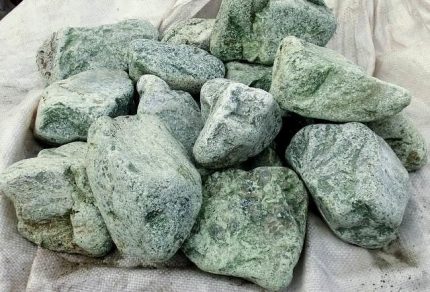
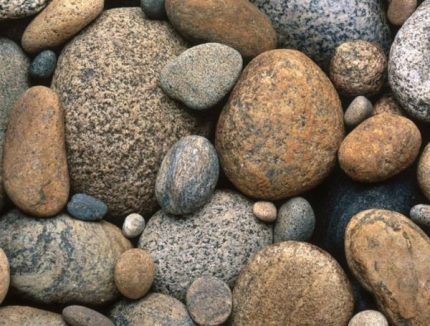
It is important that the material is homogeneous, without any impurities, because from them the stone can explode at high temperature.
Experienced bath attendants have a great way to determine which stones are ideal for a steam room in a bath, but you can only use it in practice: red-hot and throw in cold water.
Really high-quality filler can easily pass this test without forming cracks and splits.
Optimum size and weight of stones
The size of the stones directly depends on the type of the sauna stove, so they need to be chosen practically, guided not only by design considerations.
For example, for a sauna with an open heater, which warms the air to 100 degrees and above, only large and medium format samples should be used.
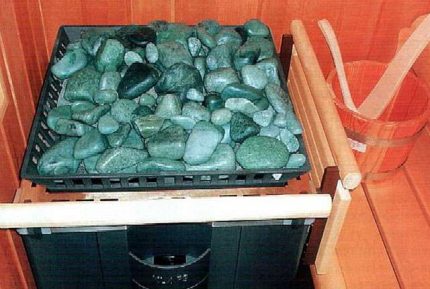
For electric heaters choose small pebbles with a diameter of 4-6 cm, and the stones should be well polished so that their sharp edges do not deform the heating element.
In a wood-burning stove, specimens of medium and large fractions, 6-18 cm in size, will last longer. Small stones are not used here, so as not to overlap the openings of the oven grate.
The amount of filler is selected individually, based on the size of the room and the type of furnace. If there are not enough stones, the bath will warm up poorly, despite the increased fuel consumption. With a large bookmark, the heater will give intense steam and heat, in which not every attendant will be comfortable.
The instructions for the purchased heaters should indicate the recommended mass and fraction of stones. For home-made saunas, you can focus on the average numbers: 1 m2 the premises require about 6 kg of stone.
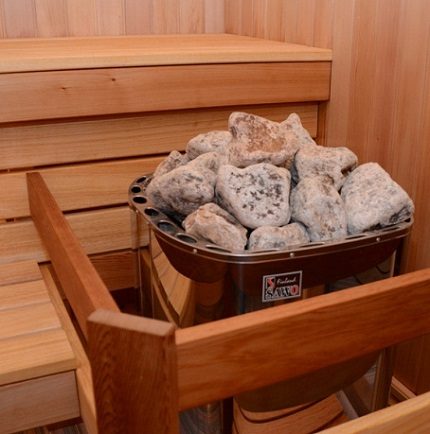
For classic bath with the furnace closed, the dimensions of the filler depend on the size of the door designed to supply water. Here, grinding is not so important, the main thing is that the stones pass freely through the hole and are compactly located inside.
Environmental safety filler
If our ancestors could collect stones for a steam room without thinking about environmental problems, then in modern realities such savings can be expensive.
For example, one should not take various stones from the embankment near the railway for the bathhouse furnace - they can be processed with creosote. This chemical substance does not erode, does not wash out and when heated turns into toxic vapor. The same applies to cobblestones from construction sites or dumps.

Do not forget that the natural material may contain radionuclides, for example, granite. Therefore, the safest option is to buy stones in specialized stores. In this case, you will be sure that the product has passed radiation control.
However, without fear, you can buy rocks that have formed at great depths, such as peridotite, jadeite or dunite - they cannot contain radioactive elements.
Varieties of bath stones
To design a bath, you can choose any filler from an impressive assortment of stores selling bath products. Each breed has its own “highlight” - it can be a long service life, a spectacular appearance or special lithotherapeutic properties.
Group # 1 - semiprecious breeds
You can decorate the design of the heater with the help of beautiful semiprecious stones. Adherents of lithotherapy assure that the addition of such fillers to the bookmark greatly enhances the healing effect of the sauna, turning it into a universal remedy for many diseases.
The most common of the semiprecious minerals is jade. It improves the condition of the kidneys, nervous system, evens out pressure, restores the bronchopulmonary and musculoskeletal system.
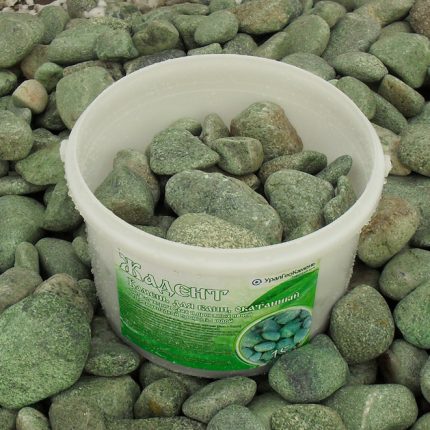
Unique properties of jadeite:
- evenly shrinks and expands when heated, without forming cracks and splits;
- It has a high density and low thermal conductivity, due to which it is able to give off stored heat over a long time
- disinfects and saturates water with metasilicic acid;
- enriches air with ions of Zn, Cu, Se, Ag.
The price per kilogram of chopped jadeite is about 140 rubles. Boned or polished will cost more - from 180 rubles / kg, depending on the fraction and the quality of processing.
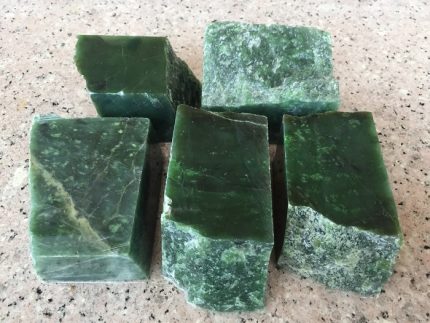
Nephritis - Another popular semiprecious stone from the group of pyroxenes. Like jadeite, this mineral has high strength and excellent heat retention.
As for color, much depends on the presence of various impurities in the composition of the stone. Although we expect a green hue from jade, the rock enriched with magnesium can be cast in pink and iron in black or dark brown. A bright emerald color is a sign of chromium.
Jade has long been valued for its high healing properties - in the East it is considered a panacea for all diseases and is called the "stone of health." But the cost of such a universal doctor is impressive - from 300 rubles / kg.
By the way, the high price of jade gave rise to many fakes - unscrupulous sellers sometimes give out an ordinary coil for an expensive bath stone, which has low strength and will not last for a long time in a steam room.
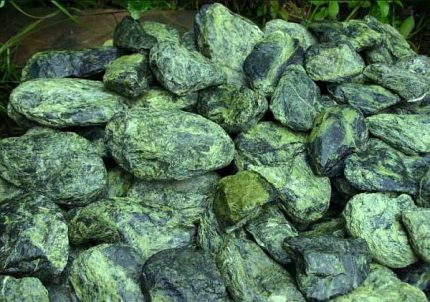
No less popular and jasper - red-brown semi-precious stone with a wide range of healing properties and excellent heat dissipation.
A bath with a jasper bookmark helps to cure the reproductive and nervous system, helps fight headaches, depression, insomnia and promotes rapid healing of wounds. The price per kilogram of stones starts from 170 rubles.
Group # 2 - artificial stones and cores
Since natural materials are quite expensive, various mixtures can be used to lay the stove.
The basis of this mix can be any stones with good thermal conductivity, including artificial fillers. And to supplement and decorate the total mass can be several breeds with healing properties.
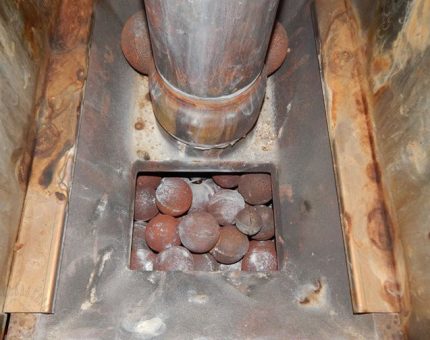
Cast iron cores, cones or shells quickly heat up themselves and are great for large rooms, because the thermal conductivity of the metal is 30 times higher than that of natural stones.
The steam from such elements turns out to be really vigorous - very hot and dry, therefore it is recommended to add stones to the bookmark. But such a filler is not guaranteed to crack at high temperatures and will last for many years.
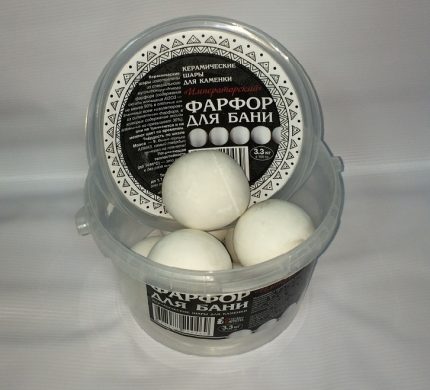
Another more popular and inexpensive filler looks more aesthetically pleasing - ceramic balls. They are obtained in the process of sintering a mixture of white clay, animal bones, quartz and feldspar.
After several firing, all organic impurities from the substance evaporate, and the resulting spheres easily withstand temperature extremes in the baths, have a high heat capacity (up to 1100 J) and give light steam.
Popular minerals and their comparison
Mineral of volcanic origin is recognized as the best filler for a bath furnace. When heated, they emit infrared radiation, can easily withstand significant temperature extremes and enrich the steam room with trace elements useful for health.
Consider the most popular types and their characteristics in the table and compare them with each other.
| Breed | Heat-bone, J | Strength, MPa | Density, kg / m3 | Healing properties | Nuances |
| Lame | 920 | 300-700 | 4500 | Strengthens the immune system, helps with diseases of the reproductive system | Depending on the field, it may contain Mg, Al, Zn |
| Peridotitis (dunitis) | 1000 | 250 | 3200 | Normalizes pressure, helps to cure a cold | Purifies air, captures carbon dioxide |
| Talkochlorite | 980 | 100-450 | 2980 | Strengthens the immune system, stimulates the synthesis of vitamin D, strengthens the musculoskeletal system | It can store heat for a day, considered a classic option for Finnish saunas |
| Quartzite (raspberry, gray, yellow) | 700 | 200-250 | 2630 | It will be useful in the treatment of vegetative-vascular dystonia, joint and pulmonary diseases. | Heats up quickly, but also cools quickly, forms light steam |
| White quartz | 750 | 200 | 2650 | Stimulates the brain and nervous system, enriches blood with oxygen | When heated and quenched, it releases atomic oxygen |
| Porphyrite | 830 | 400 | 1450 | Improves skin condition, relieves headache, strengthens the immune system and cardiovascular system | Depending on the composition, basalt, pyroxene, diorite and diabase porphyrite are distinguished |
| Basalt | 840 | 400 | 2500-2970 | Relieves stress and migraines, has a beneficial effect on the nervous and immune systems | It maintains heat for a long time, gives intense steam, has a long service life |
| Gabbro Diabase | 600-800 | 311 | 3070 | General healing effect, unique healing properties not noted | If stones with an admixture of sulfites come in, they will give off a burning smell when heated. |
As for the price, the most budgetary among natural fillers will be gabbro diabase and basalt (25-30 rubles per 1 kg). Will cost the most quartz - from 60 rubles / kg.
Terms of use and advice from bathhouse attendants
It’s not enough just to choose the right stones, because you also need to correctly place them in the furnace so that the heat is comfortable and the steam is finely dispersed and really light.
Also equally important arrange proper ventilation in a room with an electric stove or another type of oven.

Nuances of filling the stove:
- Before laying, the filler must be thoroughly washed and dried.
- The lower layers are laid in large fragments that accumulate heat well. It can be peridotitis, talcochlorite, gabbro-diabase, basalt or cast-iron kernels.
- Medium and small particles of jadeite, quartzite, jade or other rocks with suitable healing properties are placed on top.
- Stones should be placed tight enough, but not tamped. After laying, the share of air gaps should be approximately 10-15 percent of the total.
- No need to lay the filler close to the tubes and other elements of the electric heater - when heated, the stone expands and can deform the device.
- Only hot water can be poured onto the heater, and in small portions and without additives like honey, oils or beer, otherwise the stones will quickly become covered with soot and chad. If you don’t think of a bath without aromatic steam, simply dissolve the mixture in water, pour it into a metal bowl and place it on top or hang over an oven for evaporation.
- Porphyrite and other rocks may crack slightly when first calcined - this is normal. But if the crack is heard constantly, the stones should be reviewed and replaced if necessary - perhaps you got heterogeneous specimens with extraneous impurities.
And the last: do not forget to check the state of the heater at least 1 time per year and check the filler for cracks and breaks.
Damaged stones must be cleaned and replaced with new ones, and adequately passed the test with heat and steam - rinse under running water and again sent to service.
Conclusions and useful video on the topic
If you still cannot decide which stone is best to choose in a steam room for a bath, we recommend that you familiarize yourself with our selection of video materials.
Tips for choosing bath stones from a heating engineer:
An example of a combined furnace bookmark with talc chloride and raspberry quartzite:
Despite the excellent thermal characteristics of many rocks, do not forget that the mineral composition of stones can vary significantly depending on their deposits and variable factors..
Therefore, people who are versed in bathing, recommend always looking at specific samples of the material, and not just the name. And ideally, choose a filler with a person who understands the geology and structure of the stone.
What stones do you use? Share your secrets with other visitors to our site. Or maybe you want to supplement the above material with useful recommendations for the care of stones or their operation? Express your opinion in the comments on this article.

 Electric furnace for saunas and baths: TOP-12 of the best models + recommendations for customers
Electric furnace for saunas and baths: TOP-12 of the best models + recommendations for customers  Gas bath stove: TOP-10 rating of sauna stoves for Russian and Finnish baths
Gas bath stove: TOP-10 rating of sauna stoves for Russian and Finnish baths  Russian bath stove: TOP-10 and guidelines for choosing the best model of a sauna stove
Russian bath stove: TOP-10 and guidelines for choosing the best model of a sauna stove 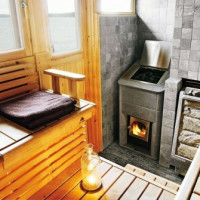 Do-it-yourself gas bath stove: manual for the installation and installation of a gas stove
Do-it-yourself gas bath stove: manual for the installation and installation of a gas stove  How to stack a stove with a stove: a detailed guide and recommendations for independent stoves
How to stack a stove with a stove: a detailed guide and recommendations for independent stoves 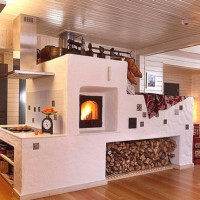 Types of brick ovens for the home: types of units according to purpose and design features
Types of brick ovens for the home: types of units according to purpose and design features  How much does it cost to connect gas to a private house: the price of organizing gas supply
How much does it cost to connect gas to a private house: the price of organizing gas supply  The best washing machines with dryer: model rating and customer tips
The best washing machines with dryer: model rating and customer tips  What is the color temperature of light and the nuances of choosing the temperature of the lamps to suit your needs
What is the color temperature of light and the nuances of choosing the temperature of the lamps to suit your needs  Replacement of a geyser in an apartment: replacement paperwork + basic norms and requirements
Replacement of a geyser in an apartment: replacement paperwork + basic norms and requirements
On a small heater in the bathhouse, we needed 130 kg of stone. We took a river, the price for it is from 15 rubles. Still used cobblestones of diabase from the old bath. The base of the heater is a metal wheel from an excavator. Large gaps between the needles were reduced by rods of steel reinforcement and only then stones were laid. However, there were gaps so that the water easily passed between them and they did not interfere with each other when they expand / decrease. Thanks to this solution, after heating, the heat dissipates evenly, and stones, even non-refractory ones, are destroyed more slowly.
When I was building a bath, I wanted to buy jade for a heater. I know about the benefits of this stone from my own experience. I went for special warming up with him to remove the inflammatory processes in the body. However, the price of jade was too high. For the bath I needed 100 kg of stone filling. Therefore, he settled on pink quartzite, which also brings great health benefits.
It is not necessary to fill the entire stove with jade. Then, of course, it turns out too expensive. 10-20 kg of jade is enough, and the rest can be clogged with a simpler mixture - jasper, quartzite, jadeite, etc.